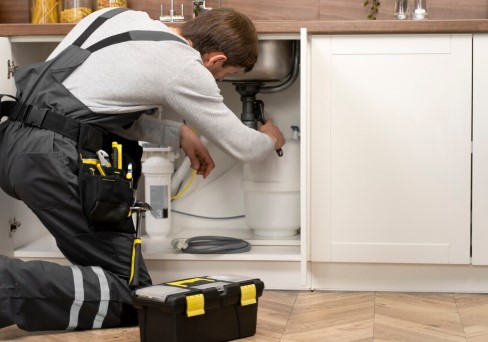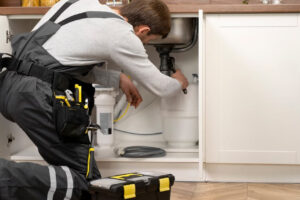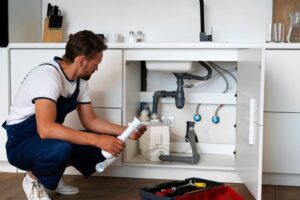
Most people don’t think about plumbing until water splashes where it shouldn’t. Whether it’s a slow-draining sink or a strange gurgle from the toilet, these signs rarely come with clear instructions. Knowing when to call for Home Plumbing Services can stop a minor issue from turning into a serious mess.
In this guide, we’ll explore everyday problems that signal deeper trouble. You’ll learn to read the early signs, understand when to handle it yourself, and know exactly when to call a professional. Plumbing issues don’t wait, and neither should you.
Common Signs That Demand a Plumber’s Visit
Sometimes, a drip or clog may seem harmless. But three common signals suggest the problem runs deeper.
1. Water Pressure Drops Suddenly
- If your shower turns from powerful to pitiful without warning, take notice. Sudden pressure loss may come from hidden leaks, pipe damage, or blockages in your supply line. Ignoring this might lead to flooding or water damage behind walls.
2. Persistent Clogs
- A plunger might clear a minor clog. But if the same toilet backs up twice a week, or your shower constantly pools water, your pipes could be telling you something’s wrong. Repeated clogs often mean a blockage deeper in the system.
3. Unusual Noises
- Gurgling drains, banging pipes, or whistling taps often hint at air trapped in your system or pressure problems. These noises might seem funny at first—but they suggest failing pipes or venting problems.
Kitchen Sink Choke – A Familiar Frustration
The kitchen is where most plumbing issues begin. A kitchen sink choke often comes with warning signs. You might notice water draining slowly, an odd smell from the pipe, or bubbling sounds.
1. Grease Buildup
- Cooking oil and fat harden inside the pipes over time. This sticky layer narrows the space water needs to flow. Even small amounts poured down daily can cause big problems.
2. Food Debris
- Bits of rice, vegetables, and coffee grounds don’t dissolve. They collect in corners and bend pipes, eventually blocking water from flowing.
3. Soap Scum and Detergent Residue
- Even liquid soap can leave film inside your pipes. When combined with other waste, it contributes to long-term blockages.
Ignoring these signs risks a full choke. Once water stands in your sink or spills onto the counter, DIY solutions stop working. You’ll need proper tools and a plumber’s skill to clear the blockage completely.
Hidden Leaks – The Silent Destroyer
Leaks rarely scream for attention. They whisper behind walls, under floors, or above ceilings.
1. Water Stains
- Brown spots or bubbling paint suggest moisture trapped inside walls or ceilings. Leaks leave slow, visible trails even if no water drips openly.
2. High Water Bills
- If your bill rises without a clear reason, suspect a hidden leak. A cracked pipe or loose joint may leak slowly but steadily.
3. Musty Smells
- Mould thrives in damp spaces. If your cabinet or cupboard smells earthy or stale, moisture could be building where you can’t see it.
Delaying action on leaks leads to serious structural damage. A leak today could mean torn walls or warped wood next month. Call a plumber as soon as these signs appear.
Drain Smells – What’s That Odour?
Foul smells from your drains can signal waste build-up or worse.
1. Dry Traps
- The U-shaped bend beneath a sink holds water that blocks sewer gas. If unused for days, this water evaporates. Gases rise back into the room.
2. Blocked Vents
- Plumbing systems need air to push water down. A clogged vent pipe forces gas to escape through drains instead of out the roof.
3. Rotting Waste
- Old food and organic waste often collect just out of reach. Over time, these decay and cause strong smells.
Odours mean something’s off. A skilled plumber can inspect your system, clear the source, and restore fresh air to your home.
When DIY Fixes Make It Worse
YouTube videos might offer simple fixes, but some repairs need more than a wrench.
1. Overusing Chemicals
- Drain cleaners eat through blockages—and your pipes. Frequent use weakens seals and damages older plumbing.
2. Loose Fittings
- One wrong twist of a spanner can loosen joints. What starts as a drip may turn into a full spray within hours.
3. Temporary Patches
- Taping a pipe or sealing a leak might work today. Tomorrow, it could fail. These temporary solutions often mask growing problems.
Know your limits. If basic tools don’t solve the issue or things get worse, call in professionals before the damage spreads.
Emergency Plumber Singapore – When Time Matters
Some plumbing problems can’t wait. Delaying action during emergencies increases risk and repair costs.
1. Burst Pipes
- A pipe that splits or cracks pours water into your home. Shut off the main valve and call an emergency plumber Singapore immediately.
2. Overflowing Toilets
- Toilets that spill onto floors pose hygiene risks. You’ll need fast, professional action to clear the blockage and disinfect the area.
3. No Water Supply
- Sudden loss of water could mean a major supply issue. It might be a city problem—or a burst pipe in your building. Either way, a plumber must inspect it quickly.
Fast response prevents further harm. Emergency plumbing teams respond around the clock. Knowing when to call could save your floors, walls, or furniture.
Plumbing Singapore – Local Conditions Matter
Every city has unique plumbing challenges. Plumbing Singapore faces several local quirks.
1. High Humidity
- Moisture from the air adds stress to already damp areas. It speeds mould growth in bathrooms and kitchens.
2. Older HDB Blocks
- Many older housing units have ageing pipes. These systems need extra care to prevent corrosion or blockages.
3. Narrow Pipe Designs
- Some apartments use smaller pipes, making them prone to choking. This design requires more frequent maintenance and careful waste disposal.
Local plumbers understand these conditions and use tools suited to Singapore’s layout and building style. Calling an experienced team helps you avoid one-size-fits-all solutions.
Do I Always Need a Plumber?
Not every issue needs a pro. Before calling someone, check if the problem matches any of these signs.
Below is a helpful table comparing minor issues you might solve yourself and major signs that call for professional help.
Quick Guide: Should You Call a Plumber?
| Symptom | DIY Possible? |
Call a Plumber? |
|
Dripping tap |
Yes | If it worsens or leaks |
|
Clogged toilet (once) |
Yes |
If recurring or overflowing |
|
Foul drain odour |
Maybe | If smell returns or spreads |
|
Low water pressure |
No |
Yes |
| Hidden leak signs | No |
Yes |
|
Burst pipe |
No | Immediately |
| Kitchen sink choke | Maybe |
If it recurs or worsens |
Use your judgement, but don’t hesitate when problems repeat or worsen.
Home Plumbing Services – What to Expect
When you call for Home Plumbing Services, knowing what to expect can ease the stress.
1. Inspection First
- Plumbers begin by assessing the problem. They’ll ask questions, examine affected areas, and sometimes run diagnostic checks.
2. Clear Explanation
- A good plumber explains the issue clearly. You’ll understand what’s wrong, what caused it, and how to fix it.
3. Follow-Up Advice
- After the repair, many offer advice to prevent recurrence. This may include changing habits, scheduling maintenance, or spotting early signs.
Professional services go beyond fixing problems—they help you avoid future ones.
Conclusion: Don’t Wait for a Flood
Plumbing doesn’t need to break down completely before you call for help. Often, the signs appear early: smells, sounds, clogs, and drops in pressure. Learn to spot these signals. Know when a DIY job falls short. Trust that calling a plumber can save time, stress, and money in the long run.
Whether it’s a sudden kitchen sink choke, a quiet leak, or a full-blown emergency, having access to reliable Home Plumbing Services makes all the difference. In a city like Singapore, where buildings age and humidity thrives, quick action keeps your home safe.


